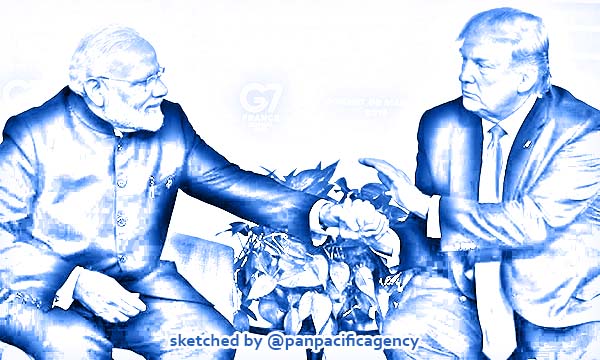[Analytics] Indo-Pacific strategy gains support as China’s assertiveness fuels fears

Indian Prime Minister Narendra Modi (L) and US President Donald Trump meet at the G7 Summit in France on August 26, 2019. The two will meet again Houston at an event called ‘Howdy Modi.’ Photo: AFP/Nicholas Kamm. Sketched by the Pan Pacific Agency.
Asia-Pacific nations are adjusting their defence strategies and looking to strengthen security ties with the United States, as anxiety grows over China’s assertiveness and a potential conflict between the two superpowers, analysts say. Kristin Huang specially for the South China Morning Post.
Washington’s Indo-Pacific strategy is seen by Beijing as an effort to rally powers like India and Japan against China’s rise in the region, which US defence chief Mark Esper has called “the epicentre of a great power competition with China”.
It extends from South Asia to the Pacific Coast of the United States, and was first outlined by President Donald Trump in Vietnam in 2017, when he called for a free and open Indo-Pacific. Since then, the US has sought to strengthen alliances in the region, and there are recent signs that the strategy is gaining momentum.
Australia, for example, in July announced an additional US$190 billion in defence spending over the next decade, with Prime Minister Scott Morrison pointing to regional tensions over territorial claims and unprecedented military modernisation.
The previous month, Philippine President Rodrigo Duterte decided not to suspend a long-standing military pact with the US – a move widely seen as a shift in strategy because of Beijing’s aggression in the disputed South China Sea. This week, he underscored his country’s claims in the resource-rich waterway in an address to the United Nations General Assembly.
Jay Batongbacal, director of the University of the Philippines Institute for Maritime Affairs and Law of the Sea, said other nations would be prompted to join the US strategy because of China’s behaviour in the region.
“China provided the US with the reason and opportunity [for the strategy], beginning with the unnecessary threats to freedom of navigation and overflight in 2015 and culminating in its coercive actions and activities against Vietnam, Malaysia and Indonesia in the past year,” Batongbacal said.
“As well as employing so-called Wolf Warrior diplomacy against Western powers that used to not have any reason to be more active and interested in the geopolitics of the Indo-Pacific region,” he added.
China’s actions to protect its interests had been “directly threatening to the surrounding states’ own legitimate interests”, Batongbacal said.
“Given China’s technological and economic resources, it would have been entirely capable of safeguarding its national interests against any prospective US actions without having to do everything it has done in the past several years,” he said.
Beijing’s aggression in the region – including its artificial island-building in the South China Sea, military drills and belligerent approach to diplomacy – and a deepening rift with Washington has seen countries like Vietnam and Malaysia seeking closer security ties, with each other and with the US.
Vietnamese Foreign Minister Pham Binh Minh told an Association of Southeast Asian Nations gathering this month that “we welcome the United States’ constructive and responsive contributions to Asean’s efforts to maintain the peace, stability and developments in the South China Sea”.
As the most vocal claimant in the South China Sea dispute, Vietnam is also strengthening security ties with nations like Japan and India.
Malaysia has become more vocal, in July rebuking China for claiming Kuala Lumpur had no right to seek the establishment of its continental shelf in the northern part of the South China Sea, in a statement to the UN.
Meanwhile, the US-led quadrilateral grouping with Japan, Australia and India, known as the Quad, has repeatedly called for rules-based order in the Indo-Pacific. Beijing has called the alliance “an anti-China front line”.
Rajeev Ranjan Chaturvedy, an adjunct fellow with the Institute for Australia India Engagement in Brisbane, said China’s assertiveness and geopolitical churnings had created regional instability.
“While Beijing talks of ‘win-win’, dialogue and peaceful development, in reality China is unilaterally trying to impose its will on the region. Any country with a contrarian view is not only disliked by Beijing, but also faces economic and other consequences,” Chaturvedy said. “So, China has created an environment of ‘my way or the highway’ which has made foreign policy choices more difficult.”
However, both Batongbacal and Chaturvedy agreed that despite the growing support for the Indo-Pacific strategy, it was still a long way from being fully realised.
Batongbacal noted it was not quite a reality yet, but said there was a relatively loose coalition of like-minded states supporting it.
According to Chen Gang, assistant director and senior research fellow of the East Asian Institute at the National University of Singapore, the Indo-Pacific vision was still largely rhetoric.
“I don’t think the relevant countries, including the United States itself, have given the Indo-Pacific initiative full play thus far,” Chen said. “Huge uncertainties lie ahead with the US presidential election just around the corner, and most governments in the region are distracted by the pandemic. ”